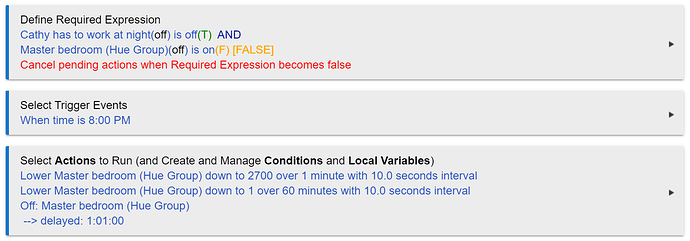The "Personal Go To Sleep" is for the kids only because I do not want it interrupted. After 30 minutes of dimming, their lights go off and it works really well. Honestly, I have not tested that one with activating a scene, but I'm pretty sure it would work.
If you used Rule Machine, here is a sample to help get you started.
With the sample, it requires both the hue group to be on and a hue scene ("Cathy has to work" is a virtual switch for Google Home to activate the scene) off. If I turn off the bulbs or activate the hue scene, it will cancel the rest of the dimming. The sample sets the color temperature to 2700 (i.e. Warm White) over the course of a minute, then dims it over the next hour down to 1%. After that, it turns off the group but that action is delayed until the dimming is over.
As for my house, I'm constantly transitioning the bulbs via a circadian rhythm and using hue scenes to stop and add color. For instance, due to the current sunlight, I have our first floor transition from wherever it is in the rhythm (around 3500 or so) down to 2600. This happens from 7-7:45pm with a dimming down to 80%. I have the sunset hue lab come on at 7:45pm every night to tell the kids to head upstairs for bed and create a nice atmosphere for the wife and I. The kids lamps go to sleep starting at 8:15pm. Starting at 9pm, the first floor dims to 10% over the next hour before activating the Moonlight scene at 10pm. Then, the first floor shuts off at 11pm after dimming down to 1%. This happens automatically unless I go to bed early and hit the "goodnight switch" to shut everything down and get the bulbs ready for the circadian rhythm in the morning.
I also dim the master bedroom similar to the sample to help us go to bed. That room from 7-8pm transitions down to 2600 at 80% from wherever it was previously. From 8-11pm, it transitions again down to 2000 at 1%.
It has taken about two months of trail and error to get to a point where everyone is extremely happy with the setup.


